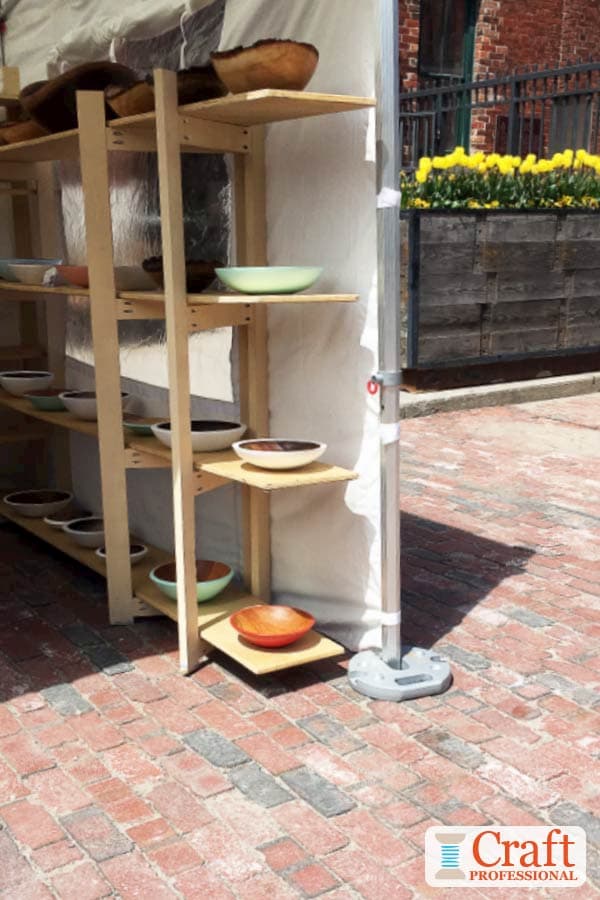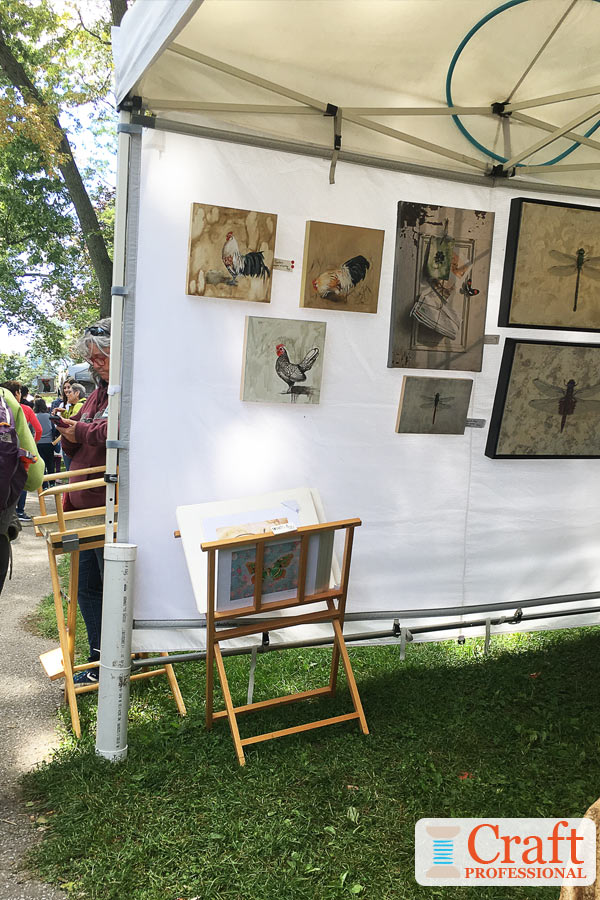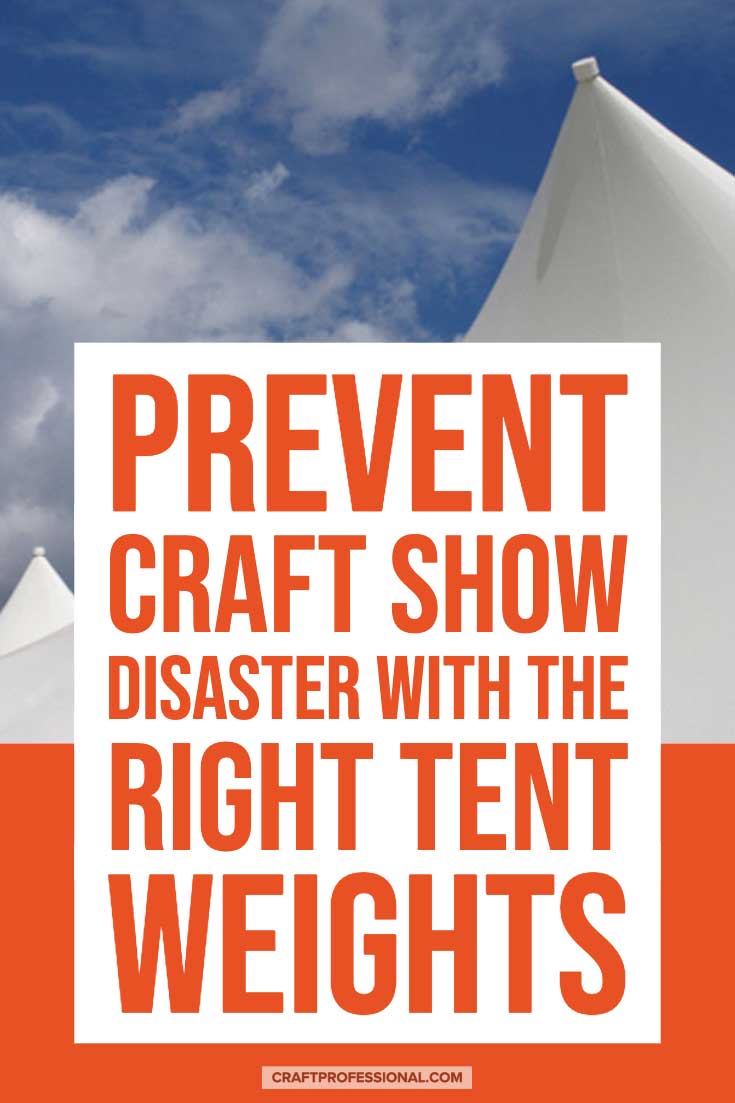Tent Weights to Anchor Your Craft Canopy
Canopy tent weights are absolutely essential for outdoor craft shows. If you don't want to worry about your portable canopy taking flight in a bit of wind, you must properly secure it. Here's how to choose the right ready-made weights, or DIY your own canopy weights to anchor your pop up tent.
If you're not convinced you need tent weights to anchor your canopy at craft shows, take your unweighted tent out in your back yard, put up a sidewall, and wait for a gentle breeze.
Be ready to catch your tent!
How much wind can a canopy take?
Not much when it isn't secured with tent weights .
It's shocking how easily just a small amount of wind can send a craft tent sailing across the street, particularly when you put up one or more of the side walls. Ask me how I know!
If you want to make sure your craft tent does not:
- damage your inventory
- damage the inventory of craft vendors near you
- or injure someone at a show
you must secure it properly.
In fact, many craft show rules wisely require that all tents must be properly weighted.
Choose the Right Tent Weights for your PoP Up Canopy
To help you understand your options for securing your canopy, whether you need to anchor your canopy on concrete or on grass, we'll look at:
- Tent weights vs. tent anchors
- Suspended weights vs. weights secured to the base of your canopy frame leg
- DIY weights vs. store-bought
Tent Weights vs. Tent Anchors
The two primary ways to secure a tent are with weights or tent anchors. Occasionally, you may be able to use anchors, but, for the most part, craft vendors will need actual weights to secure their tent.
Tent Anchors
Tent anchors are stakes that can be driven into the ground and attached to your tent to keep it fixed in place, just like you would secure a camping tent. Some brands of craft tents come with stakes included.

You're allowed to use this type of anchor to secure your portable canopy at some, but not all craft shows.
Many outdoor craft shows are street festivals where the tents are set up on cement. Obviously, tent stakes are out of the question at this type of event.
What you might be surprised to learn, is you can't use tent stakes at every show that's in a park. Some shows that are held in parks, where craft tents are set up on grass, forbid the use of tent anchors in the grass.
Because you will often be unable to anchor your tent, you can't rely on using only the stakes that come with your craft show canopy. You must have a strategy to secure your tent with weights. Of course, you can anchor your tent with stakes as added security when you are able to, but do know that tent anchors do not take the place of canopy weights.
Tent Weights
Tent weights are versatile. They can be used in any situation and on any surface.
They do have their downsides. Tent weights can be:
- heavy to transport (People often recommend you use about 40 pounds of weight on each leg of your craft tent, and some shows require even more than that per leg)
- harder to set up than stakes
- and take up more space when packed than tent anchors
However, they really are a necessary part of your outdoor craft show booth.
I earn a commission for purchases made through links on this page.
To learn more, please see my disclosure.
Suspended Weights vs. Weights Secured to the Base of Your Canopy Frame Leg

Canopy weights are either suspended from the top corners of your outdoor canopy or secured to the base of each leg.
I won't even pretend to understand the physics of suspended canopy weights vs. weights that sit on the ground, so I'm not going to get into the pros and cons of weighting your tent with hanging weights vs. using weights secured to the base of your tent legs from the point of view of how each system reacts to the wind.
Some craft show organizers have specific requirements about the type of tent weights you must use. Therefore, my suggestion would be to research the requirements of craft shows that you plan to attend.
Find the rules for vendors published on the shows' websites, and determine their requirements for weighting craft tents. They may specify the type of weights required and the amount of weight you need to use per leg. Once you know those requirements, ensure you buy or make a system of tent weights that will comply with the rules of shows you plan to attend
Homemade Canopy Weights vs. Store-Bought
Plenty of professional craft artists use their own homemade systems for weighting tents. Homemade canopy weights can be custom made to specifically meet your particular needs.
Store bought weights, on the other hand, are extremely convenient, and they are typically not that much more expensive to buy when compared with the cost of making your own tent weights.
Although I personally prefer store bought weights, plenty of craft artists make their own.
Store-Bought Canopy weights
If you plan to buy your tent weights, there are a few types on the market and features to consider and compare.
There are weights that consist of heavy plates, which are secured to the base of your tent leg and require no filling. These weights are heavier to transport than fillable weights, but they are convenient.
Pre-filled weight plates are ready to install, so there's no extra work for you when you're already busy setting up for a big craft show.
You can also buy fillable weights, which may be emptied and filled with sand and/or water. If you know you'll have access to sand or water at the show you're attending, fillable weights can lighten you load while traveling.
If you make the choice to fill your weights at the show, you will be adding an extra task to the already busy job of setting up your craft tent. However, you could always fill your weights at home if you don't want to deal with that extra task before a show.
Tent Weight Brands
There are weights made by companies that also manufacture popular craft tents such as Caravan, EZ Up and King Canopy, which allow you to stay within one family of products for your craft tent-related supplies.
How to Make Your Own Canopy Weights
If you plan to make your own tent weights, there are a few solutions that people have used including:
- PVC pipe weights
- large buckets
Homemade PVC Pipe Weights
PVC pipes filled with concrete (or sometimes sand), are used by many professional craft artists.
To make your own PVC pipe tent weights you will need:
- PVC pipe (typically white to blend with the tent)
- Concrete
- End caps
- Eye bolts
To make your own PVC pipe weights, simply fill a length of 3-4 inch PVC pipe with concrete (Quikrete is a popular brand and is available at many home building supply stores).

The length and diameter of the pipe you choose will depend on how much you want the pipe to weigh. Many people aim for 40 pounds of weight on each leg, but you may want to create 8 pipes that weigh 20 pounds each (2 pipes for each tent leg), so each weight isn't so heavy to carry. 20 pound weights will be easier to manage than 40 pound weights.
If you go to a home building supply store that provides good customer service, they will be able to help you do the math on the amount of concrete (and, therefore, the size of PVC pipe) you will need to create the amount of weight you want.
Secure end caps onto one end of each PVC tube. Mix the concrete according to directions, and pour into the PVC pipes.
After you pour the mixed concrete in the pipe, and before it sets, insert a ring bolt into each weight, which will allow you to hang the weights if you like. You can also secure the weights to the legs of your tent with some white velcro wrapped around the pipe and the leg to prevent the weights from swinging around.
Large Bucket Weights
Large buckets are less attractive than white PVC pipe, but they are a simple and inexpensive solution.
Some craft show vendors simply fill large buckets with sand or water and suspend those buckets from the corners of their craft tents or secure them to the base of the tent legs.
If you are filling buckets with water, you'll need 5 gallons of water for 40 pounds of weight. If you are filling buckets with sand, you'll need about 3.2 gallons of sand to create a 40 pound weight.
One benefit of filling large buckets with water or sand is that, if you know you will have access to water or sand at the show, you can fill them up at the location and avoid carrying a lot of extra weight. However, you will not have access to water or sand at every show. Also, filling your weight buckets at the show will add one more step to your set up process.
A few craft artists like to bring along a few large buckets to use as additional backup weights on particularly windy days. They may use store bought weights, or another homemade system as their primary tent weights, and they simply add water or sand-filled buckets to the system on days when they feel they need a little extra weight.
Because this type of canopy weight is not very attractive, you will probably want to find a way to cover them up. A simple solution is to hang curtains from each corner of your craft tent, and tie off the curtains so that the buckets are hidden within the folds of the curtains.



New! Comments
Have your say about what you just read! Leave me a comment in the box below.